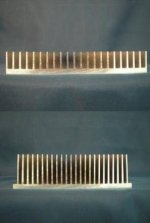SupraSPL
Member
aha I can see how that could use some explaining. We calculate the surface area of the heatsink and based on that it will cool a certain amount of dissipation watts. I think KNNA is recommending 110cm2 per watt now and that number will fall as the LEDs get more efficient. If you add a fan the number drops further.
So if a heatsink has very tall fins it will have more watts attached to it but covering the same space, increasing the light density. It would not be difficult to increase the light density too far because photosynthetic efficiency decreases at higher photon densities. It is better to spread that light as evenly as possible and to stay within the recommended light density range (I think KNNA recommends 250-300 dissipation watts per sq meter but that may have decreased because we have better white bins and better red spectrum now.)
For vegging you can use a much lower light density and still get HID like growth or better, so in those cases it is helpful to use heatsinks that have shorter fins or lower surface areas.
So if a heatsink has very tall fins it will have more watts attached to it but covering the same space, increasing the light density. It would not be difficult to increase the light density too far because photosynthetic efficiency decreases at higher photon densities. It is better to spread that light as evenly as possible and to stay within the recommended light density range (I think KNNA recommends 250-300 dissipation watts per sq meter but that may have decreased because we have better white bins and better red spectrum now.)
For vegging you can use a much lower light density and still get HID like growth or better, so in those cases it is helpful to use heatsinks that have shorter fins or lower surface areas.





 other people's lights.
other people's lights.

